 |
|
|
| (Information by Peter Kessler, with additional information by Edward Dawson, from The Mongol Empire: Genghis Khan: His Triumph and his Legacy, Peter Brent (Book Club Associates, 1976), from The Mongols: A Very Short Introduction, Morris Rossabi (Oxford University Press, 2012), from the BBC documentary, The Secret History of Genghis Khan, broadcast 28 December 2011), from the New World Encyclopaedia, from Crimean Tatars, H B Paksoy, from The Origins of Northern China's Ethnicities, Zhu Xueyuan (Beijing 2004), from The History of the Medieval World: From the Conversion of Constantine to the First Crusade, Susan Wise Bauer (2010), from Asimov's Chronology of the World, Isaac Asimov, from Genghis Khan, Paul Ratchnevsky (Thomas Nivison Haining, Trans & Ed, Cambridge, Massachusetts, 1991), and from External Links: Origins of the Volga Tatars, and Tatar.net (dead link), and The True Origin of the Mongols?, John Man (Oxford Alumni, 28 July 2020).) |
|
|
| 1238 |
Batu Khan of the Golden Horde and Subedei devastate the already-subjugated Crimea and subdue Mordovia and the Kipchaks on the steppe. 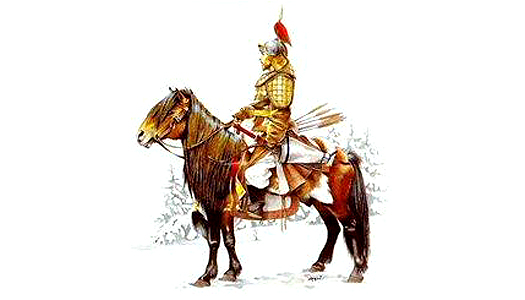 Batu Khan extended the borders of Mongol power into the lands of the Rus, bringing them under the domination of the Golden Horde for a century Batu Khan extended the borders of Mongol power into the lands of the Rus, bringing them under the domination of the Golden Horde for a century |
|
| 1282 - 1283 |
The power struggle between Toqta of the Golden Horde and Nogai Khan of the Nogai Horde flares up into open conflict, and Toqta is the eventual victor. Nogai's territories, which reach from Crimea and the southern Rus principalities to Wallachia, are divided by Toqta between Nogai's brother, Sareibugha, and his sons. |
|
| 1299 - 1300 |
The ongoing conflict between Pisa and Genoa reaches a head. Genoa has recently gained additional influence and power by extending its maritime empire to parts of Crimea (with the permission of the Golden Horde), allowing it to establish the colony of Kaffa (Caffa). It has also made a highly-profitable alliance with the resurgent Eastern Roman empire which directly impacts upon the ability of Pisa and Venice to compete commercially. In 1282, Pisa attempts to gain administrative and commercial control of Corsica when the giudice of Cinarca, Sinucello, revolts against Genoese dominance and requests support from Pisa. The situation quickly escalates from a Genoese blockade of Pisan trade on the island to full-scale war. 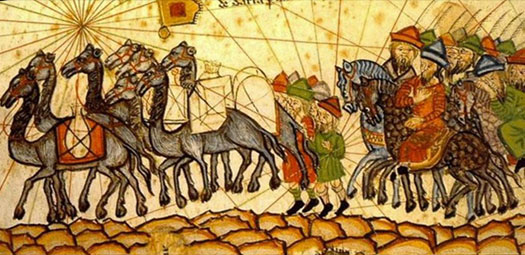 Marco Polo's journey into China along the Silk Road made use of a network of east-west trade routes which had been developed since the time of Greek control of Bactria Marco Polo's journey into China along the Silk Road made use of a network of east-west trade routes which had been developed since the time of Greek control of Bactria |
|
| 1343 - 1345 |
Jani Beg leads a massive Crimean Tartar force against the Crimean port city of Kaffa. The assault turns into a siege which is lifted by a Genoese relief force. Two years later, Jani Beg returns, but the second attack against Kaffa is defeated by an outbreak of Black Plague. There is a possibility that Jani Beg's army catapult their infected fellow troops into Kaffa so that the defenders will become infected. The ploy fails to bring the city to its knees, but infected Genoese sailors subsequently take the Black Death with them back to [Italy](ItalyKingdom.htm#Lords of Milan). |
|
| 1349 - 1356 |
? |
Crimea's governor. Member of the Blue Horde. |
| 1356 - ? |
Ali Beg |
Crimea's governor. Died fairly soon after gaining post. |
| 1357 - 1359 |
With the assassination of Jani Beg, the political cohesion of the Golden Horde begins to disintegrate. Berdi Beg is probably behind Jani Beg's death, and his reign as khan is not universally accepted. 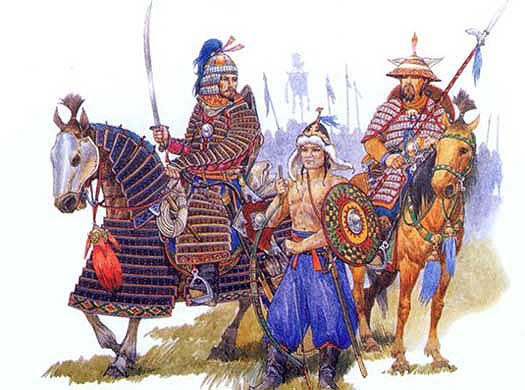 The Mongols maintained their dominance of the eastern Rus with bloodletting where necessary, burning and destroying towns which stood against them The Mongols maintained their dominance of the eastern Rus with bloodletting where necessary, burning and destroying towns which stood against them |
|
| The khanate goes from being able to claim titular dominance over the three ulus (Blue Horde, White Horde, and Chaghatayids) and actual dominance over the Rus to internecine warfare and the possibility of complete dissolution. Their territory is curtailed to the southern Ukrainian steppe and the Crimean peninsula. |
|
|
| ? - 1359 |
Qutluq-Timur |
Son. Died. |
| 1359 |
Qutluq-Buqa |
Member of another family. Usurped in Crimea. |
| 1359 - 1380 |
Mamai |
Brother of Timur. Soon de facto Blue Horde ruler. |
| 1367 |
Descended from the same Borjigin clan as Chingiz Khan, Mamai is a powerful military leader in the Golden Horde and also governor of the Crimean peninsula. During the khanate of Berdi Beg, Mamai had gained the office of beylerbay, making him head of the supreme court along with giving him the offices of military general and minister of foreign affairs. 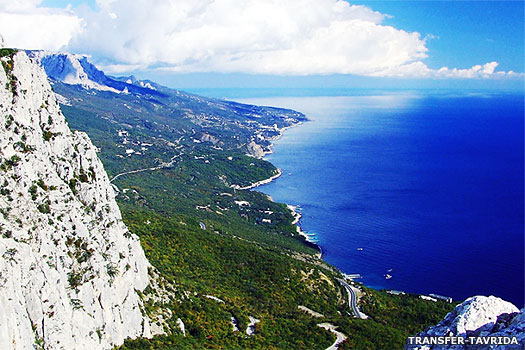 Crimea's southern coast largely consists of mountains and sharp descents towards the sea line, all of which was inhabited by the Tauri and then the Tauric Ostrogoths Crimea's southern coast largely consists of mountains and sharp descents towards the sea line, all of which was inhabited by the Tauri and then the Tauric Ostrogoths |
|
| Since then he has been playing power politics with the shifting allegiances and claims for power. Now he supports the claim by Abdullah Khan to rule the Blue Horde and firmly establishes himself as the true power behind the weakened throne. |
|
|
| 1378 - 1380 |
The Blue Horde is heavily defeated by the Muscovites under Demetrius Donski at the Battle of the River Vozha. Two years later the horde is defeated again by the Rus, at the Battle of Kulikovo. Mamai begins putting together a retaliatory force but is defeated by Toqtamish Khan of the White Horde in a battle on the banks of the River Kalka. Mamai flees to his base in Crimea where he is assassinated in Kaffa in the same year by the Genoese, who are still upset that a unit of Genoese crossbowmen had been totally annihilated by the Rus while in the service of the Blue Horde. 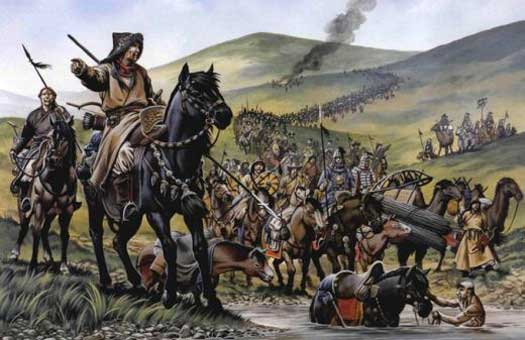 The White Horde ruled the territory between Lake Balkhash and the Volga, while initially continuing to push westwards as part of the greater Golden Horde The White Horde ruled the territory between Lake Balkhash and the Volga, while initially continuing to push westwards as part of the greater Golden Horde |
|
| The Blue Horde itself is fully reunited with the White Horde to form a greater Golden Horde, and the immediate impact is that Crimea is swiftly drawn back under its control. |
|
|
| 1427 |
Following the assassination of Baraq of the Golden Horde, his rival, Dawlat Berdi, establishes a base in Crimea which he is able to defend even against an attempted invasion by Ulugh Muhammad in 1430. This defeat is claimed as the reason for the otherwise mysterious death of Vytautas 'the Great' of [ Lithuania](EasternLithuania.htm#Grand Duchy of Lithuania) in his role as Ulugh's main supporter. However, despite the best attempts by Dawlat, he is never entirely able to defeat Hajji Giray, a powerful local khan who goes onto establish his own independence as the first khan of Crimea. 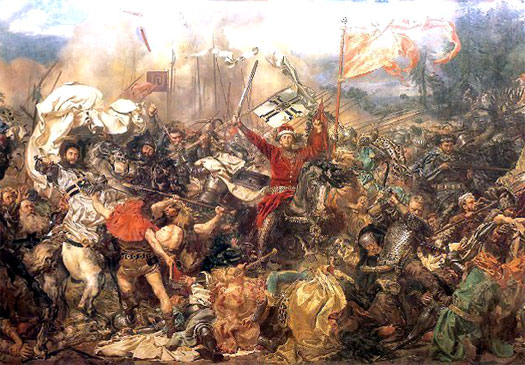 Moscow fought a series of wars against the then-dominant Grand Duchy of Lithuania & Ruthenia (the latter being western Rus) during the fifteenth century, but Moscow's eventual victory would present it with new threats, such as the Tartars of the powerful Crimean khanate (click or tap on image to view full sized) Moscow fought a series of wars against the then-dominant Grand Duchy of Lithuania & Ruthenia (the latter being western Rus) during the fifteenth century, but Moscow's eventual victory would present it with new threats, such as the Tartars of the powerful Crimean khanate (click or tap on image to view full sized) |
|
| 1427 - 1432 |
Dawlat Berdi / Devlet |
Restored. Reduced to Crimea only. Assassinated. |
| 1432? - 1449 |
Hajji Giray I / Haci Giray |
Now dominant. Established Crimean khanate 1443/1449. |
| 1449? |
Having been unsuccessful in his challenge for the throne of the Golden Horde, the assassination of Dawlat Berdi in 1432 has left the route open to Hajji Giray setting up the 'Crimean Khanate' as an independent entity under his command. |
|
|
|
|
| Khans of the Crimea / Little Tartary (Tartars) AD 1449 - 1783 The Mongols appear to have been born out of an amalgam of native Turkic and Tungusic groups in north-eastern Central Asia and East Asia. The famous Mongol foundation epic, the Secret History of the Mongols, states that the Mongols reached the steppe from over the 'Tengis' - the sea or lake - twenty-two generations before the birth of 'Chingiz Khan' in AD 1162. This famous figure, Chingiz Khan, was the first of the 'Great Khans' of the Mongol empire. His death in 1227 created the basis for the empire's later sub-division, something which increasing internal feuding would ensure. In 1246, Batu Khan converted his territories into a khanate which became known as the Blue Horde. His brothers did the same to form the White Horde and the Shaibanids. In 1378 the weakened blue and white hordes were reunited as a single Golden Horde. The Eastern European khanate of the Crimea was a splinter state of the disintegrating Golden Horde. It occupied territory stretching from the west of the Caspian Sea, with the Astrakhan khanate between it and the Caspian Sea itself, over to areas of central Ukraine. Centred on the Crimean peninsula, the territory had previously fallen under the control of the Blue Horde, and was governed for quite some time by Mamai, governor of (Mongol) Crimea and Mongol military leader, and de facto power behind the throne in the mid-fourteenth century. During the early fifteenth century, the Golden Horde became increasingly weakened, as one would-be usurper after another claimed power. One of those claimants, Dawlat Berdi, managed to establish himself in Crimea in 1427. He was constantly troubled by Hajji Giray, a would-be ruler of the horde as a whole and, failing that, a would-be ruler of his own independent domain. The assassination of Dawlat Berdi in 1432 left the route open to Hajji setting up the Crimean khanate as an independent entity under his command, having been unsuccessful in his challenge for the throne of the Golden Horde. The actual date of the take-over is somewhat disputed, with 1443 and 1449 being two of the favourites. Along with its sometime ally, the Nogai Horde or khanate, the Crimean khanate raided Slavic settlements across what is now Russia, Ukraine, Moldova, and Belarus. Slaves were captured from southern Muscovy, Poland, Moldavia, Wallachia, and Circassia by Tartar (or Tatar) horsemen in a trade which was known as the 'harvesting of the steppe'. In Podolia alone, about one-third of all villages were destroyed or abandoned between 1578 and 1583. Some researchers estimate that altogether more than three million people were captured and enslaved during the existence of the Crimean khanate. The khanate also maintained claims on most the territories of the former Golden Horde, especially those between the Dniester and Volga rivers. This resulted in frequent cross-border raids on both sides, but in time it began to take a toll on Tartar numbers and strength, leaving it vulnerable to conquest by the growing Russian empire. Also referred to as Little Tartary in late medieval and early modern European sources, the khanate was formed of Tartar Turkics who settled amongst the earlier Crimean populations (including the Tauri and Tauric Ostrogoths) to produce a specific Tartar ethnic group. It possessed a formidable military organisation, something which is made clear by the privileged position afforded to it by the Ottomans. Despite this it remains uncertain exactly how large was the Tartar army. This is important when one wishes to consider what the Tartar army's military potential could have been, and what they may have been able to achieve if properly supported by the Ottomans. Alan Fisher, for example, conservatively estimates Tartar military strength at around forty or fifty thousand. Other sources place the number around eighty thousand, or even further to figures reaching as high as two hundred thousand, although this latter figure is almost certainly an exaggeration. |
|
|
 |
|
|
| (Information by Peter Kessler, with additional information from Josafa Barbaro & Ambrogio Contarini: Travels to Tana and Persia, Henry E J Stanley (Ed, Hakluyt Society Series No 49, 1873), from An Introduction to the History of the Turkic Peoples, Peter B Golden (1992), from the Encyclopaedia Britannica: Or, A Dictionary of Arts, Sciences, and Miscellaneous Literature, Enlarged and Improved, Volume 3, from The Encyclopaedia of Islam (New Edition), C E Bosworth, E van Donzel, B Lewis, & Ch Pellat (Eds), from The Sultan's Raiders: The Military Role of the Crimean Tatars in the Ottoman Empire, Brian Glyn Williams (2013), from The Crimean Khanate between East and West (15th-18th Century), Denise Klein (Ed, 2012), from The Crimean Tatars, Alan W Fisher (1978), from The Russian Annexation of the Crimea 1772-1783, Alan W Fisher (1970), from Slave Trade in the Early Modern Crimea, Mikhail Kizilov, and from External Links: Encyclopaedia.com, and History Cooperative, and World of Royalty.) |
|
|
| 1449 - 1456 |
Hajji Giray I / Haci Giray |
Seized Crimea from Dawlat. Independent of Golden Horde. |
| 1453 |
The Eastern Roman capital at Constantinople is finally captured by Ottoman Sultan Mehmed II, bringing to an end the last vestiges of the Roman empire and making Greece an Ottoman province. The loss is viewed as a disaster for the Christian world, but it also completely realigns the balance of power amongst the Turkic tribes and kingdoms to the east and north. 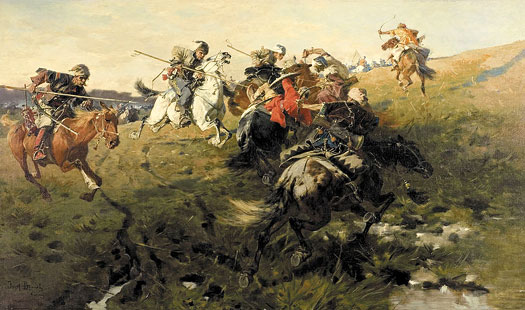 Tartars of the Crimean khanate fight Cossacks from the Ukrainian steppe, a scene which would be repeated many times over the course of the khanate's three hundred year-plus existence Tartars of the Crimean khanate fight Cossacks from the Ukrainian steppe, a scene which would be repeated many times over the course of the khanate's three hundred year-plus existence |
|
| Hajji Giray moves quickly to establish a military alliance with Sultan Mehmed, someone he sees as a potential partner in his wars against the Golden Horde. The first instance of Crimean Tartars and the Ottoman military cooperating occurs only a year later, when Giray Khan sends seven thousand troops to assist in Mehmed's siege of the Genoese colony of Caffa (or Kaffa), which is situated on the southern Crimean coast. Although it is ultimately unsuccessful, the expedition sets a precedent for future Ottoman-Tartar cooperation. |
|
|
| 1456 |
Haydar Giray |
Son. Revolted and briefly seized the throne. Expelled. |
| 1456 - 1466 |
Hajji Giray I / Haci Giray |
Restored in the same year. Died. |
| 1465 - 1466 |
With the success of Ahmad Khan in gaining power over the Golden Horde, the Kazakh khanate is formed by Jaybeg Khan, son of Baraq Khan, and the following year the Astrakhan khanate is also formed as a splinter state of the disintegrating Golden Horde. 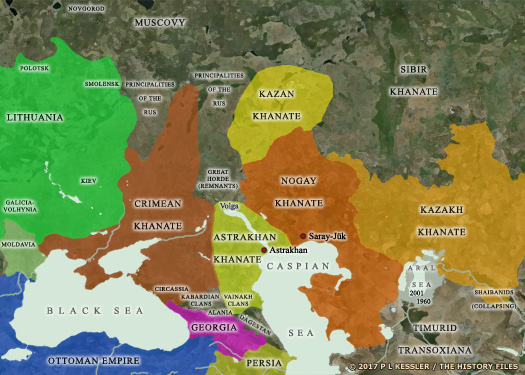 The Mongol empire created by Chingiz Khan gradually broke up over the course of three hundred years until, by around AD 1500, it had fragmented into several more-or-less stable khanates which vied for power and influence, while fending off the Ottoman empire to the south and Moscow state to the north (click or tap on map to view full sized) The Mongol empire created by Chingiz Khan gradually broke up over the course of three hundred years until, by around AD 1500, it had fragmented into several more-or-less stable khanates which vied for power and influence, while fending off the Ottoman empire to the south and Moscow state to the north (click or tap on map to view full sized) |
|
| With Hajji Giray dead in Crimea in 1466, the Golden Horde's remnants become known as the Great Horde. In Crimea, Hajji's two sons plunge the khanate into civil war in their battle for dominance. |
|
|
| 1466 - 1467 |
Nur Dawlat Giray |
Son. First rule. Overthrown by his brother in civil war. |
| 1467 - 1474 |
Mengli Giray |
Brother. First rule, for only a few months. Overthrown. |
| 1474 - 1475 |
Nur Dawlat Giray |
Restored. Defeated and expelled by Golden Horde. |
| 1474 - 1475 |
Ambrogio Contarini is a Venetian diplomat and merchant who, during his travels, records his adventures throughout the east as a form of travelogue. As the envoy of Venice, he has been visiting the royal court at Isfahan in 1474 in pursuit of a military alliance with the dominant White Sheep emirate against the mutually hostile Ottomans. 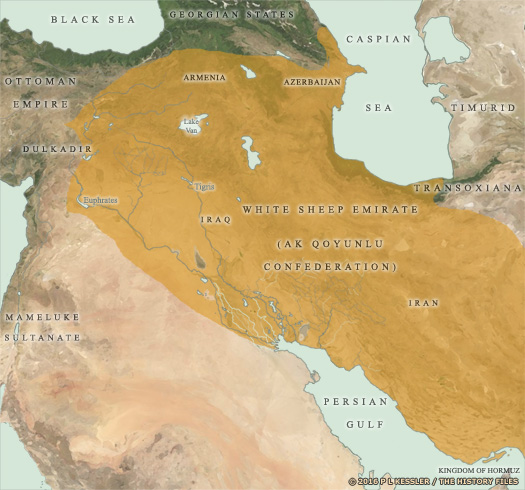 The White Sheep emirate, or Ak Qoyunlu confederation, at its height controlled a great area of territory, stretching from Azerbaijan in the north to the Persian Gulf and eastern Iran (click or tap on map to view full sized) The White Sheep emirate, or Ak Qoyunlu confederation, at its height controlled a great area of territory, stretching from Azerbaijan in the north to the Persian Gulf and eastern Iran (click or tap on map to view full sized) |
|
| The talks are largely fruitless so in 1475 Contarini begins a circuitous return which must by necessity avoid the Ottomans. The task is even more difficult because, at the start of 1475, they conquer both Genoese Caffa and the disrupted Crimean khanate. The latter remains an Ottoman vassal to its very end. |
|
|
| 1475 - 1476 |
Mengli Giray |
Second rule. First Ottoman vassal ruler. Dispossessed. |
| 1476 - 1478 |
Nur Dawlat Giray |
Briefly returned in the struggle for power, but finally expelled. |
| 1478 - 1514 |
Mengli Giray |
Third rule. Destroyed the Great Horde. |
| 1480 |
In alliance with Mengli Giray, Moscow's Ivan III refuses tribute to the Great Horde. The latter, now allied to [ Lithuania](EasternLithuania.htm#Grand Duchy of Lithuania), attempts an invasion of Moscow's territory but this fails. The independence of Moscow is confirmed. The Tartars do, however, capture Ivan Chodkiewicz, voivode of Kyiv, along with his family. The latter are ransomed but Ivan does in captivity. |
|
| 1491 |
The Crimean khanate apparently seizes all of the Great Horde's horses, and encourages Moscow to deliver the death blow as a result. Both Moscow and the Ottomans dispatch forces which include Russian cavalry, Tartars, and Janissaries. This causes part of the horde to secede in November 1491, while the remainder is routed by its enemies. 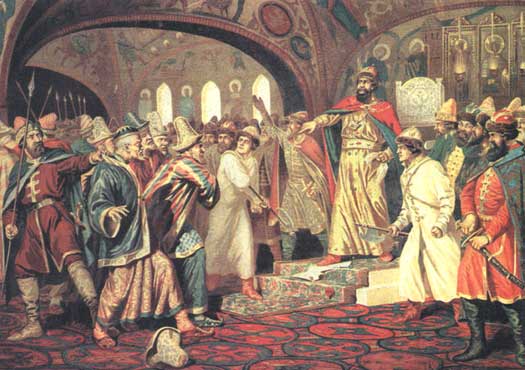 Ivan III of Moscow tears up the Mongol demand for tribute in front of his own court and the Mongol messengers, ending once and for all Mongol dominance over the Rus Ivan III of Moscow tears up the Mongol demand for tribute in front of his own court and the Mongol messengers, ending once and for all Mongol dominance over the Rus |
|
| 1502 |
Much of the Great Horde's people and horses are captured by Mengli Giray and forcibly relocated to Crimea, while Shaykh Ahmad flees with about four thousand horsemen. It is not clear whether this is a repetition of the events of 1491 or a separate event. However, this time Shaykh Ahmad days are numbered, and the Great Horde is unable to reform. The Mongol heartland continues to survive farther east as the Northern Yuan whilst a remnant of the Great Horde succeeds it as the Astrakhan khanate. |
|
| 1515 - 1522 |
Muhammad Giray I / Mehmed Giray |
Son. Murdered. |
| 1517 |
With the death of Dayan Khan of the Northern Yuan Mongols far to the east of Crimea, his selected successor is the youthful Bars Bolud Jinong Khan. Dayan Khan's third son, Bodi Alagh Khan, fears that the boy's youth and inexperience will undo the work of reuniting the Mongols, so he pushes the boy aside to claim the khanship himself. He is largely supported by the nobility who have the same fears.  Various Mongol clans were vying for supremacy in the fifteenth century, destabilising what was left of unity and statehood Various Mongol clans were vying for supremacy in the fifteenth century, destabilising what was left of unity and statehood |
|
| Dayan Khan's death also sparks a proliferation of minor Mongol dynasties which further fragments Mongolian unity. He has divided his domains between his eleven sons, with the youngest, Gersenz Hongtaiji, gaining Northern Khalkha (which approximates modern Outer Mongolia in terms of its territory). |
|
|
| 1521 |
Shah Alî of the Qasim khanate, and latterly ruler of the Kazan khanate, is driven out by Sahib Giray I, Muhammad's son, due to the former's friendly relations with Moscow. Kazan's territory is incorporated back into that of Crimea under the rule of Muhammad Giray. |
|
| 1523 - 1524 |
Ghazî Giray I |
Son. Died. |
| 1524 - 1532 |
Sa'adat Giray I |
Son of Mengli Giray. Died. |
| 1532 |
Islam Giray I |
Brother of Ghazî Giray I. Deposed. Died. |
| 1532 - 1551 |
Sahib Giray I |
Son of Muhammad Giray I. Khan of Kazan (1546). Died. |
| 1541 |
Sahib Giray invades the territory of Moscow, fighting a key engagement at the Battle of the Oka, to the east of Moscow. The Tartar force is defeated, blunting their ambitions to extend the khanate northwards.  Nogais, also known as mangyts - people of the Nogai Horde - referred to their state as the Mangyt Yurt, with the earliest references being found in Turkish, Russian, and Western European sources Nogais, also known as mangyts - people of the Nogai Horde - referred to their state as the Mangyt Yurt, with the earliest references being found in Turkish, Russian, and Western European sources |
|
| 1547 |
The city of Astrakhan is briefly seized by Sahib Giray, but it would seem that Khan Yaghmurchi is able to recover and return to restore his own rule over the city. Following Astrakhan's fall to the Russians a decade later, Crimea tries hard to regain the city for itself, ultimately unsuccessfully. |
|
| 1551 - 1577 |
Dawlat Giray I / Devlet / Dolat |
Grandson of Mengli Giray. Installed by the Ottomans. Died. |
| 1571 - 1572 |
The Russia of Ivan 'the Terrible' is no stranger to battles for territory, but Ivan also has to defend his own borders. Raids by the Crimean Tartars are a constant threat, with the most serious of them taking place in 1571. This sees Moscow in flames, but the Russians gain their revenge in the following year, at the Battle of Molodi. |
|
| 1577 - 1584 |
Muhammad Giray II / Mehmed |
Son. Died. |
| 1584 - 1588 |
Islam Giray II |
Brother. Died. |
| 1588 - 1596 |
Ghazi Giray II 'Bora' |
Brother. 'Bora' means 'storm'. Briefly usurped by his brother. |
| 1596 |
Fetih Giray I |
Brother. Usurper with Ottoman support. Captured. Executed. |
| 1596 - 1608 |
Ghazi Giray II |
Restored. Died. |
| 1603 |
Legdan Hutuhtu becomes Northern Yuan khan at a time at which the authority of his position is greatly in decline, at least partially thanks to the constant subdivision of Mongol territory and the creation of lesser khanates.  A late Oirat warrior - Oirats survive to this day in Russia, China, and Mongolia, still speaking Oirat dialects of the Mongolian language A late Oirat warrior - Oirats survive to this day in Russia, China, and Mongolia, still speaking Oirat dialects of the Mongolian language |
|
| 1608 |
Toqtamish Giray |
Son of Fetih. Lost a power struggle against Salamat. Killed. |
| 1608 - 1610 |
Salamat Giray I / Selamet |
Son of Muhammad Giray II. Secured throne. Died 2 years later. |
| 1610 |
A brief attempt by Muhammad Giray III to rule the Tartars begins yet another series of internal battles as he struggles for dominance against Jani Beg Giray. Together with his brother, Şahin Giray, Muhammad also battles against Khan Temir of the Budzhak Horde, and attempts to build alliances with the Polish-Lithuanian commonwealth and the Zaporozhian Cossacks of the lower Dnieper rapids in the Ukraine. 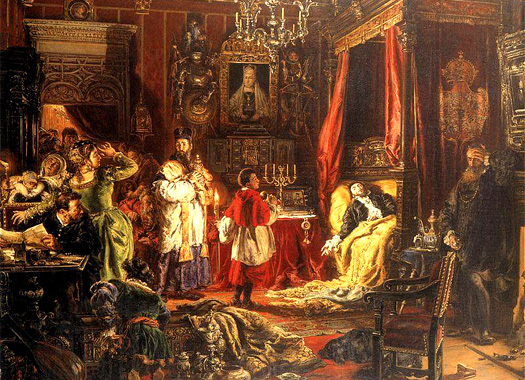 The death of Sigismund II Augustus, the last hereditary Lithuanian ruler of Poland as depicted by Jan Matejko, which signalled the end of Lithuania's independence from Poland The death of Sigismund II Augustus, the last hereditary Lithuanian ruler of Poland as depicted by Jan Matejko, which signalled the end of Lithuania's independence from Poland |
|
| 1610 |
Muhammad Giray III |
Grandson of Muhammad Giray III. Ousted before year's end. |
| 1610 - 1623 |
Jani Beg Giray / Canibek |
First rule after usurping Muhammad. |
| 1623 - 1624 |
Muhammad Giray III / Mehmed |
Second rule. |
| 1624 |
Jani Beg Giray |
Second rule. Ottoman appointment but did not reach Crimea. |
| 1624 - 1627 |
Muhammad Giray III / Mehmed |
Third rule. |
| 1627 - 1635 |
Jani Beg Giray |
Third rule. |
| 1635 - 1637 |
Inayat Giray |
Son of Ghazi Giray II. |
| 1637 - 1641 |
Bahadur Giray I |
Son of Salamat Giray. Died. |
| 1639 |
Ulan Bator is founded as a nomadic Buddhist monastic centre. It is not settled permanently until 1778, and in the twentieth century it becomes the capital city of Outer Mongolia, home of the last free Mongols. 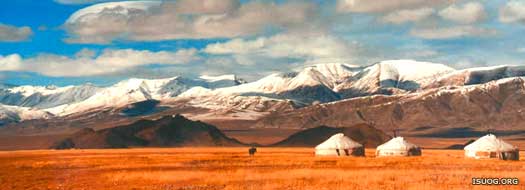 The plains around Ulan Bator offer stereotypical views of traditional Mongol territory - wide, sweeping plains that were (and still are) ideally suited to horse-borne warriors The plains around Ulan Bator offer stereotypical views of traditional Mongol territory - wide, sweeping plains that were (and still are) ideally suited to horse-borne warriors |
|
| 1641 - 1644 |
Muhammad Giray IV / Mehmed Sufi Giray |
Brother. First rule. |
| 1644 - 1654 |
Islam Giray III |
Brother. Died June 1654. |
| 1654 - 1655 |
Poland-Lithuania is dragged into the Russo-Polish War over the control of Ukraine, in the Polish Commonwealth's far eastern territories. Russian troops seize the most important centres of the [ Lithuanian](EasternLithuania.htm#Grand Duchy of Lithuania) grand duchy - Smolensk, Vitebsk, Mogilev, and Minsk - and for the first time in Lithuanian history Vilnius is occupied, followed shortly afterwards by Kaunas and Grodno. The commonwealth's king is exiled between September and November in 1655. The turning point in relations between the Ottomans and Russia comes at the same time, upon the union of the Dnieper Cossacks with Russia. This presents the Crimean khanate and the Ottoman empire with a formidable challenge to their influence and their claims of suzerainty over the Ukrainian steppe. 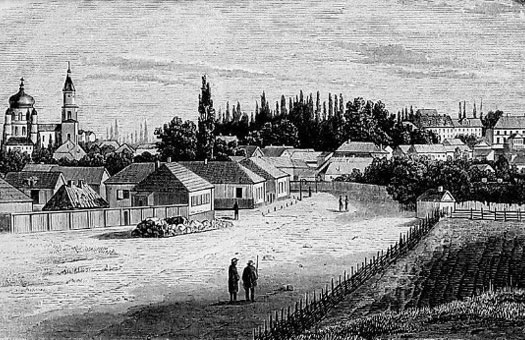 Legendarily founded in 884 by Zhytomyr, a prince of the Drevlians, the city which bears his name is first mentioned in 1240, became the Polish capital of its half of Ukraine in 1667, and even today houses the country's largest Polish community Legendarily founded in 884 by Zhytomyr, a prince of the Drevlians, the city which bears his name is first mentioned in 1240, became the Polish capital of its half of Ukraine in 1667, and even today houses the country's largest Polish community |
|
| 1654 - 1666 |
Muhammad Giray IV / Mehmed |
Second rule. Died 1672/4. |
| 1666 - 1671 |
Âdil Giray |
Grandson of Fetih. Poland-Lithuania candidate (1669). |
| 1671 - 1678 |
Salim Giray I |
Son of Bahadur. Ottoman appointment to replace Âdil. |
| 1678 |
The rapid growth of Russian territory finally prompts a serious Ottoman campaign to expel the Russians from the Ukraine. A large Ottoman army is sent against them, supported by Crimean Tartar cavalry. The offensive culminates in the siege of the strategic city of Cihrin. Russian attempts to relieve the city fail, and the Ottomans are able to secure a favourable treaty. However, although the Russians are temporarily pushed back, continued warfare along the Polish frontier forces the Ottomans to discontinue their Ukrainian campaign. 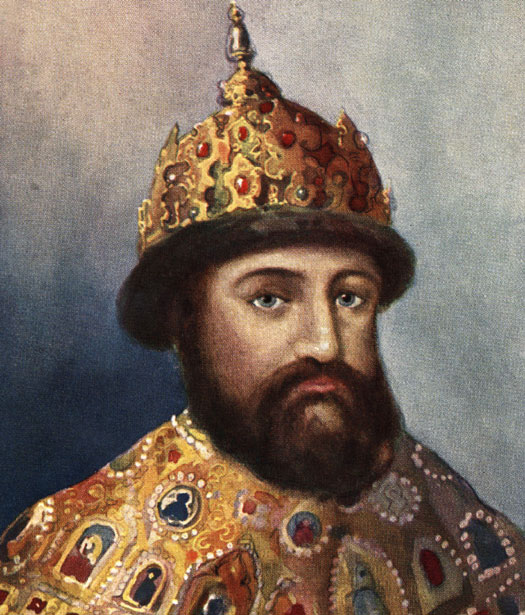 Michael Romanov was the first Russian czar of the House of Romanov, but it would be his successors who turned the czarate of the Russias into an empire Michael Romanov was the first Russian czar of the House of Romanov, but it would be his successors who turned the czarate of the Russias into an empire |
|
| 1678 - 1683 |
Murad Giray |
Grandson of Salamat Giray. Replaced disgraced Salim. |
| 1683 - 1684 |
Hajji Giray II |
Grandson of Salamat Giray. Dethroned. |
| 1684 - 1691 |
Salim Giray I |
Second rule. Resigned due to differences with Ottoman vizier. |
| 1691 |
Sa'adat Giray II |
Brother of Hajji Giray II. |
| 1691 - 1692 |
Safa Giray / Sefa |
Grandson of Salamat Giray. Unpopular. Removed by Ottomans. |
| 1692 - 1699 |
Salim Giray I |
Third rule. Resigned after Treaty of Karlowitz signed. |
| 1696 |
While the Ottomans are preoccupied in the Balkans against [Austria](GermanyAustria.htm#Habsburg Archdukes), Poland-Lithuania, and Venice, Peter 'the Great' leads an attack against the Ottoman fortress of Azov in the heart of the Crimean khanate. He finally captures it in this year at the Battle of Azov, although the Tartars manage to evade two other Russian invasions during the war. This series of campaigns signal the beginning of an ominous new era in the khanate's relationship with Russia, as its neighbour is able to steadily penetrate its frontier as never before. 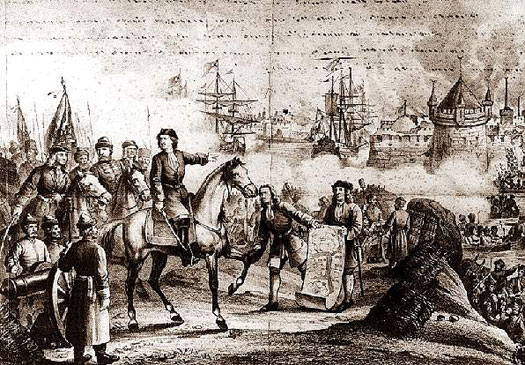 The Battle of Azov in 1696 saw the Russia of Peter 'the Great' seize the Ottoman fortress of Azov on the coast of the small sea of the same name while the Ottomans were caught up in a Balkans war The Battle of Azov in 1696 saw the Russia of Peter 'the Great' seize the Ottoman fortress of Azov on the coast of the small sea of the same name while the Ottomans were caught up in a Balkans war |
|
| 1699 |
The Treaty of Karlowitz is signed on 26 January 1699 at Sremski Karlovci (now in Serbia). This brings to a conclusion the Austro-Ottoman War of 1683-1697 which had witnessed the defeat of the Ottomans at the Battle of Zenta. The Ottoman advance in Europe is stopped in its tracks, and is even partially reversed for the first time. This allows [Austria](GermanyAustria.htm#Habsburg Archdukes) to rise as a dominant player in European politics. Khan Salim of the Crimean Tartars resigns his position following the treaty's signing while Austria takes control of Transylvania. |
|
| 1699 - 1702 |
Dawlat Giray II |
Son of Salim Giray I. Removed for planning war against Russia. |
| 1702 - 1704 |
Salim Giray I |
Recalled again by the Ottomans. Settled internal discord. Died. |
| 1704 - 1707 |
Ghazi Giray III |
Son. |
| 1707 - 1708 |
Qaplan Giray I |
Brother. First rule. |
| 1708 - 1713 |
Dawlat Giray II |
Second rule. Removed by the Ottomans. Died 1719. |
| 1713 - 1716 |
Qaplan Giray I |
Second rule. |
| 1716 - 1717 |
Dawlat Giray III |
Son of Salim Giray I. Died after 1724. |
| 1717 - 1724 |
Sa'adat Giray III |
Son of Salim Giray I. Died 1732. |
| 1722 - 1723 |
Sensing the weakness of the Safavid empire, Peter 'the Great' launches the Russo-Persian War of 1722-1723. Otherwise known as the 'Persian Expedition of Peter 'the Great', the war is designed to increase Russian influence in the Caucasus and prevent the Ottoman empire from increasing its own regional authority. 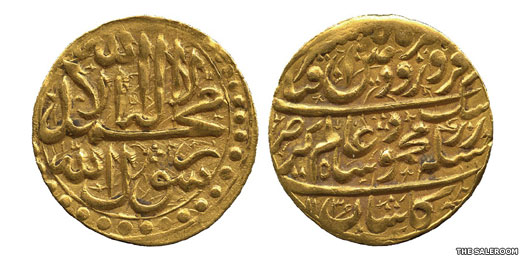 Two sides of a coin issued under Mahmud Shah of the Hotaki dynasty of early Afghanistan, the ruler of a new, centrist Afghan ruling elite who managed to defeat the Safavids and occupy large areas of Iran for seven years Two sides of a coin issued under Mahmud Shah of the Hotaki dynasty of early Afghanistan, the ruler of a new, centrist Afghan ruling elite who managed to defeat the Safavids and occupy large areas of Iran for seven years |
|
| Astrabad, Baku, Derbent, Gilan, Mazandaran, and Shirvan are all successfully won (only to be subsequently leased back to Persia between 1732-1735 now that the two states are allies). |
|
|
| 1724 - 1730 |
Mengli Giray II |
Brother. First rule. |
| 1730 - 1736 |
Qaplan Giray I |
Third rule. Removed for failures during the war. |
| 1735 - 1739 |
The recent Ottoman-Persian War and the subsequent peace treaty results now in the Austro-Russo-Turkish War (1735-1739). The main excuse for the war is continued raiding for slaves by the Crimean khanate on the Cossack Hetmanate of Ukraine, and a Crimean military excursion into the Caucasus. The Russians plunge deep into poorly-defended Crimean territory, burning as they go. Even the Ottoman fortress at Azov is captured, so that the caliph at Constantinople is forced to remove Crimean khans Qaplan Giray I (in 1736) and Fetih Giray II (in 1737) from their positions for their failures. Plague also sweeps through the combatants, sometimes reducing the fighting to little more than minor border skirmishes. [Austria](GermanyAustria.htm#Habsburg Archdukes)'s own participation in the war against the Ottomans in 1737 ends in several Austrian defeats. 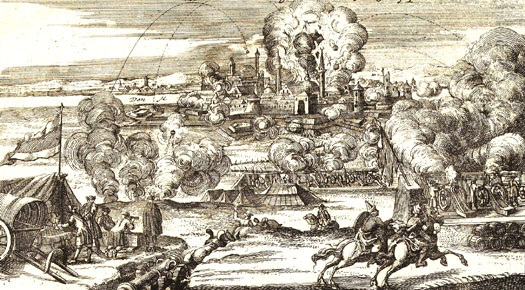 The Siege of Azov in 1736 was part of the greater Austro-Russo-Turkish War (1735-1739) and saw the Russians capture the Ottoman fortress of Azov for a second, and final, time The Siege of Azov in 1736 was part of the greater Austro-Russo-Turkish War (1735-1739) and saw the Russians capture the Ottoman fortress of Azov for a second, and final, time |
|
| 1736 - 1737 |
Fetih Giray II |
Died 1747. Removed for failures during the war. |
| 1737 - 1740 |
Mengli Giray II |
Second rule. Died. |
| 1740 - 1743 |
Salamat Giray II |
Son of Salim Giray I. Died 1751. |
| 1743 - 1748 |
Salim Giray II |
Son of Qaplan Giray I. Died. |
| 1748 - 1756 |
Arslan Giray |
Son of Dawlat Giray III. First rule. |
| 1756 - 1758 |
Halim Giray |
Son of Sa'adat Giray III. Died. |
| 1758 - 1764 |
Qirim Giray / Kirim |
Son of Dawlat Giray III. First rule. Deposed by Salim Giray III. |
| 1764 - 1767 |
Salim Giray III |
Nephew (son of Fetih II). First rule. |
| 1767 |
Arslan Giray |
Second rule. Died. |
| 1767 - 1768 |
Maqsud Giray |
Son of Salamat Giray II. First rule. |
| 1768 - 1769 |
Qirim Giray / Kirim |
Second rule. Died. |
| 1768 - 1774 |
The Russo-Turkish War is part of Catherine 'the Great's move to secure the conquest of territory on Russia's southern borders. Following the repression of revolts in Poland-Lithuania, Russia becomes involved in chasing rebels across the southern border into Ottoman territory. The Ottomans imprison captured Russian forces, effectively declaring war. 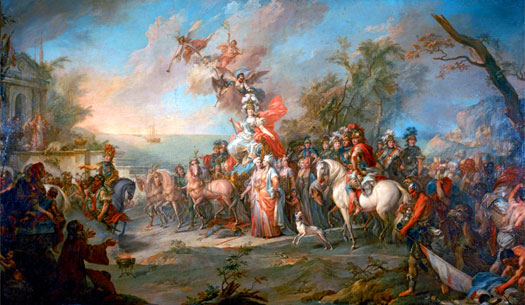 Torelli Stefano's Allegory of Catherine 'the Great's Victory over the Turks and Tatars was painted in 1772, combining images of concrete historical personages with figures from the artists' free-flying imagination - the painting was commissioned to glorify the victory of the Russian army in the first Russo-Turkish War (1768-1774) and Catherine is portrayed as the goddess Minerva in a triumphal chariot (click or tap on image to view full sized) Torelli Stefano's Allegory of Catherine 'the Great's Victory over the Turks and Tatars was painted in 1772, combining images of concrete historical personages with figures from the artists' free-flying imagination - the painting was commissioned to glorify the victory of the Russian army in the first Russo-Turkish War (1768-1774) and Catherine is portrayed as the goddess Minerva in a triumphal chariot (click or tap on image to view full sized) |
|
| During the war, with Russia distracted, the Crimean Tartars launch what is possibly their last raid to gather slaves, and certainly their last major raid. In 1769, the raid results in the capture of twenty thousand slaves: Russians and [ Ruthenians](EasternLithuania.htm#Grand Duchy of Lithuania) (Latinised Russians). Only the eventual Russian annexation of the region puts a stop to the endemic slave trade. |
|
|
| 1769 |
Dawlat Giray IV |
First rule. |
| 1769 - 1770 |
Qaplan Giray II |
Son of Salim Giray II. Died 1771. |
| 1770 - 1771 |
Salim Giray III |
Second rule. Died 1781 or 1786. |
| 1771 - 1772 |
Maqsud Giray |
Second rule. Ottoman appointment. Did not reach Crimea. |
| 1772 - 1775 |
Sahib Giray II |
Son of Salim Giray III. Died 1807. |
| 1774 |
Despite being slow to mobilise during the Russo-Turkish War, Russia now wins Kabardia (in the North Caucasus), part of the Yedisan between the Bug and Dnieper (now covering south-western Ukraine and south-eastern Moldova (southern Transnistria), and Crimea.  The official transfer of Crimea to Ukraine by the Soviet authorities in 1954 was entirely in keeping with the deep historical, economic, and logistical ties which have connected the peninsula to the Ukrainian mainland for centuries The official transfer of Crimea to Ukraine by the Soviet authorities in 1954 was entirely in keeping with the deep historical, economic, and logistical ties which have connected the peninsula to the Ukrainian mainland for centuries |
|
| [Georgia](EasternGeorgia.htm#Kingdom of Kartl-Kakheti) now joins the Russian empire as a client kingdom while the khanate of Crimea is granted nominal independence by Russia from the Ottomans by the Treaty of Kuchuk-Kainardji. In reality, Crimea has simply swapped one vassal ruler (which had been content to work with its vassal khans as partners) for another (which is intent on total domination of the Pontic steppe). |
|
|
| 1775 - 1777 |
Dawlat Giray IV |
Second rule, now as a Russian vassal. Died 1780/1. |
| 1777 - 1782 |
Shahin Giray |
Nephew of Qirim Giray. First rule. |
| 1782 - 1783 |
Bahadur II Giray |
Died c.1792. |
| 1783 - 1787 |
Shahin Giray |
Second rule. Russian vassal. Removed and later executed. |
| 1783 - 1786 |
Despite having guaranteed its independence in 1774, the Russians under Catherine 'the Great' now formally annexe the khanate of Crimea. This removes any possibility of Ottoman influence or domination. In 1786 Catherine takes part in a procession in the Crimea to celebrate the event, which itself sparks the Second Russo-Turkish War. 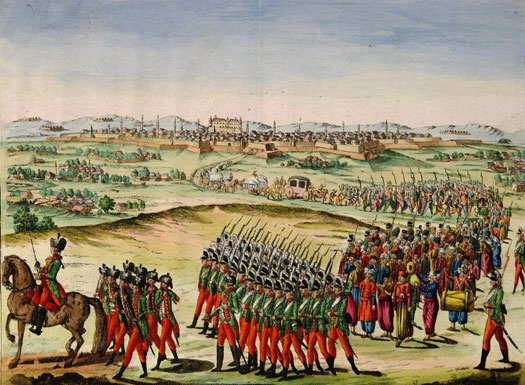 The Second Russo-Persian War in 1787-1792 witnessed a continuation of imperial Russia's push to extend its borders southwards at the expense of the weakening Muslim powers The Second Russo-Persian War in 1787-1792 witnessed a continuation of imperial Russia's push to extend its borders southwards at the expense of the weakening Muslim powers |
|
| 1787 - 1789 |
Şahbaz Giray |
Claimant for the throne but did not rule. Died 1793. |
| 1789 - 1792 |
Baht Giray |
Claimant for the throne but did not rule. Died 1801. |
| 1792 |
The Ottoman empire loses the Second Russo-Turkish War. One result is that potential inheritors of the Crimean khanate give up any hope of reclaiming the territory, especially in the face of a Russian policy of removing Tartar influences and even language from the peninsula. Crimea remains a possession of the Russian empire and then the Soviet Socialist republic for two hundred and seventeen years before the break-up of the Soviet empire results in Crimea and Ukraine becoming a single independent nation state. |
|
 |
|
|

 Batu Khan extended the borders of Mongol power into the lands of the Rus, bringing them under the domination of the Golden Horde for a century
Batu Khan extended the borders of Mongol power into the lands of the Rus, bringing them under the domination of the Golden Horde for a century Marco Polo's journey into China along the Silk Road made use of a network of east-west trade routes which had been developed since the time of Greek control of Bactria
Marco Polo's journey into China along the Silk Road made use of a network of east-west trade routes which had been developed since the time of Greek control of Bactria The Mongols maintained their dominance of the eastern Rus with bloodletting where necessary, burning and destroying towns which stood against them
The Mongols maintained their dominance of the eastern Rus with bloodletting where necessary, burning and destroying towns which stood against them Crimea's southern coast largely consists of mountains and sharp descents towards the sea line, all of which was inhabited by the Tauri and then the Tauric Ostrogoths
Crimea's southern coast largely consists of mountains and sharp descents towards the sea line, all of which was inhabited by the Tauri and then the Tauric Ostrogoths The White Horde ruled the territory between Lake Balkhash and the Volga, while initially continuing to push westwards as part of the greater Golden Horde
The White Horde ruled the territory between Lake Balkhash and the Volga, while initially continuing to push westwards as part of the greater Golden Horde Moscow fought a series of wars against the then-dominant Grand Duchy of Lithuania & Ruthenia (the latter being western Rus) during the fifteenth century, but Moscow's eventual victory would present it with new threats, such as the Tartars of the powerful Crimean khanate (click or tap on image to view full sized)
Moscow fought a series of wars against the then-dominant Grand Duchy of Lithuania & Ruthenia (the latter being western Rus) during the fifteenth century, but Moscow's eventual victory would present it with new threats, such as the Tartars of the powerful Crimean khanate (click or tap on image to view full sized)
 Tartars of the Crimean khanate fight Cossacks from the Ukrainian steppe, a scene which would be repeated many times over the course of the khanate's three hundred year-plus existence
Tartars of the Crimean khanate fight Cossacks from the Ukrainian steppe, a scene which would be repeated many times over the course of the khanate's three hundred year-plus existence The Mongol empire created by Chingiz Khan gradually broke up over the course of three hundred years until, by around AD 1500, it had fragmented into several more-or-less stable khanates which vied for power and influence, while fending off the Ottoman empire to the south and Moscow state to the north (click or tap on map to view full sized)
The Mongol empire created by Chingiz Khan gradually broke up over the course of three hundred years until, by around AD 1500, it had fragmented into several more-or-less stable khanates which vied for power and influence, while fending off the Ottoman empire to the south and Moscow state to the north (click or tap on map to view full sized) The White Sheep emirate, or Ak Qoyunlu confederation, at its height controlled a great area of territory, stretching from Azerbaijan in the north to the Persian Gulf and eastern Iran (click or tap on map to view full sized)
The White Sheep emirate, or Ak Qoyunlu confederation, at its height controlled a great area of territory, stretching from Azerbaijan in the north to the Persian Gulf and eastern Iran (click or tap on map to view full sized) Ivan III of Moscow tears up the Mongol demand for tribute in front of his own court and the Mongol messengers, ending once and for all Mongol dominance over the Rus
Ivan III of Moscow tears up the Mongol demand for tribute in front of his own court and the Mongol messengers, ending once and for all Mongol dominance over the Rus Various Mongol clans were vying for supremacy in the fifteenth century, destabilising what was left of unity and statehood
Various Mongol clans were vying for supremacy in the fifteenth century, destabilising what was left of unity and statehood Nogais, also known as mangyts - people of the Nogai Horde - referred to their state as the Mangyt Yurt, with the earliest references being found in Turkish, Russian, and Western European sources
Nogais, also known as mangyts - people of the Nogai Horde - referred to their state as the Mangyt Yurt, with the earliest references being found in Turkish, Russian, and Western European sources A late Oirat warrior - Oirats survive to this day in Russia, China, and Mongolia, still speaking Oirat dialects of the Mongolian language
A late Oirat warrior - Oirats survive to this day in Russia, China, and Mongolia, still speaking Oirat dialects of the Mongolian language The death of Sigismund II Augustus, the last hereditary Lithuanian ruler of Poland as depicted by Jan Matejko, which signalled the end of Lithuania's independence from Poland
The death of Sigismund II Augustus, the last hereditary Lithuanian ruler of Poland as depicted by Jan Matejko, which signalled the end of Lithuania's independence from Poland The plains around Ulan Bator offer stereotypical views of traditional Mongol territory - wide, sweeping plains that were (and still are) ideally suited to horse-borne warriors
The plains around Ulan Bator offer stereotypical views of traditional Mongol territory - wide, sweeping plains that were (and still are) ideally suited to horse-borne warriors Legendarily founded in 884 by Zhytomyr, a prince of the Drevlians, the city which bears his name is first mentioned in 1240, became the Polish capital of its half of Ukraine in 1667, and even today houses the country's largest Polish community
Legendarily founded in 884 by Zhytomyr, a prince of the Drevlians, the city which bears his name is first mentioned in 1240, became the Polish capital of its half of Ukraine in 1667, and even today houses the country's largest Polish community Michael Romanov was the first Russian czar of the House of Romanov, but it would be his successors who turned the czarate of the Russias into an empire
Michael Romanov was the first Russian czar of the House of Romanov, but it would be his successors who turned the czarate of the Russias into an empire The Battle of Azov in 1696 saw the Russia of Peter 'the Great' seize the Ottoman fortress of Azov on the coast of the small sea of the same name while the Ottomans were caught up in a Balkans war
The Battle of Azov in 1696 saw the Russia of Peter 'the Great' seize the Ottoman fortress of Azov on the coast of the small sea of the same name while the Ottomans were caught up in a Balkans war Two sides of a coin issued under Mahmud Shah of the Hotaki dynasty of early Afghanistan, the ruler of a new, centrist Afghan ruling elite who managed to defeat the Safavids and occupy large areas of Iran for seven years
Two sides of a coin issued under Mahmud Shah of the Hotaki dynasty of early Afghanistan, the ruler of a new, centrist Afghan ruling elite who managed to defeat the Safavids and occupy large areas of Iran for seven years The Siege of Azov in 1736 was part of the greater Austro-Russo-Turkish War (1735-1739) and saw the Russians capture the Ottoman fortress of Azov for a second, and final, time
The Siege of Azov in 1736 was part of the greater Austro-Russo-Turkish War (1735-1739) and saw the Russians capture the Ottoman fortress of Azov for a second, and final, time Torelli Stefano's Allegory of Catherine 'the Great's Victory over the Turks and Tatars was painted in 1772, combining images of concrete historical personages with figures from the artists' free-flying imagination - the painting was commissioned to glorify the victory of the Russian army in the first Russo-Turkish War (1768-1774) and Catherine is portrayed as the goddess Minerva in a triumphal chariot (click or tap on image to view full sized)
Torelli Stefano's Allegory of Catherine 'the Great's Victory over the Turks and Tatars was painted in 1772, combining images of concrete historical personages with figures from the artists' free-flying imagination - the painting was commissioned to glorify the victory of the Russian army in the first Russo-Turkish War (1768-1774) and Catherine is portrayed as the goddess Minerva in a triumphal chariot (click or tap on image to view full sized) The official transfer of Crimea to Ukraine by the Soviet authorities in 1954 was entirely in keeping with the deep historical, economic, and logistical ties which have connected the peninsula to the Ukrainian mainland for centuries
The official transfer of Crimea to Ukraine by the Soviet authorities in 1954 was entirely in keeping with the deep historical, economic, and logistical ties which have connected the peninsula to the Ukrainian mainland for centuries The Second Russo-Persian War in 1787-1792 witnessed a continuation of imperial Russia's push to extend its borders southwards at the expense of the weakening Muslim powers
The Second Russo-Persian War in 1787-1792 witnessed a continuation of imperial Russia's push to extend its borders southwards at the expense of the weakening Muslim powers